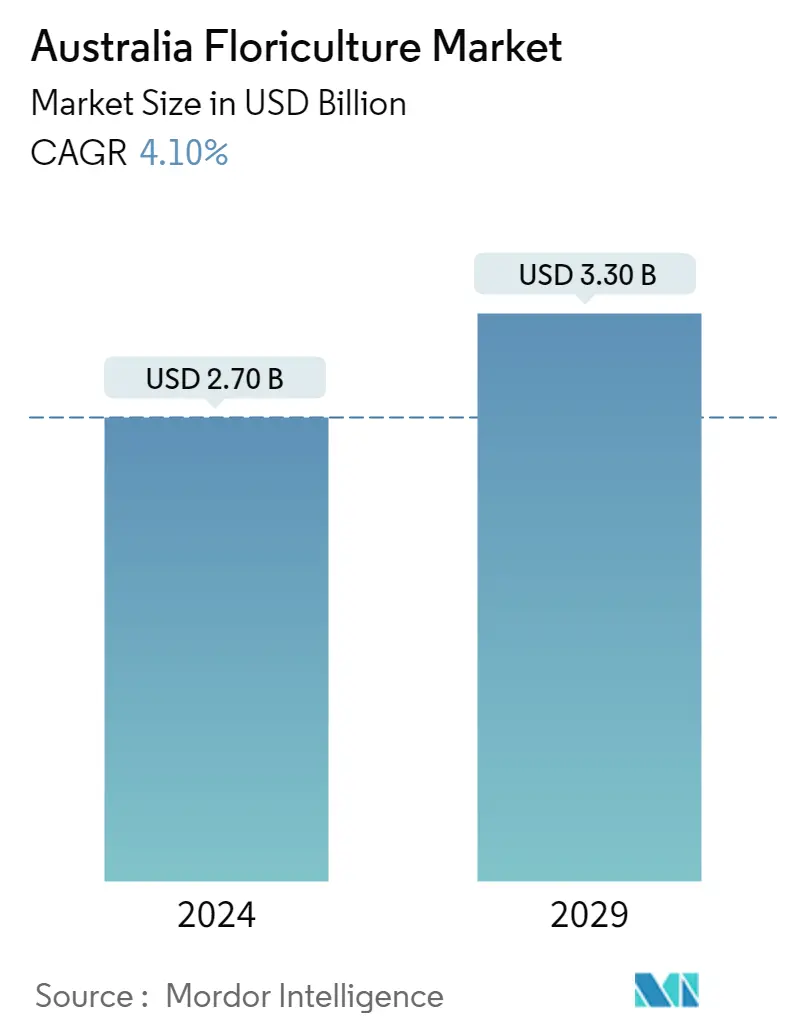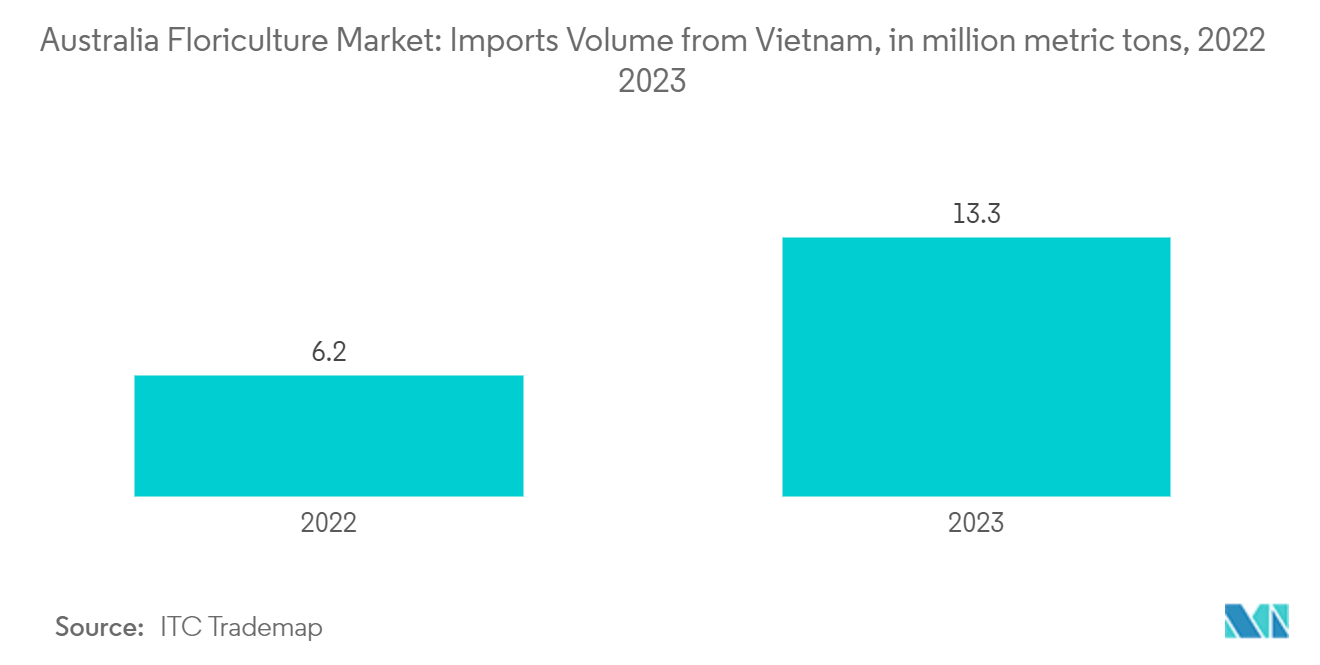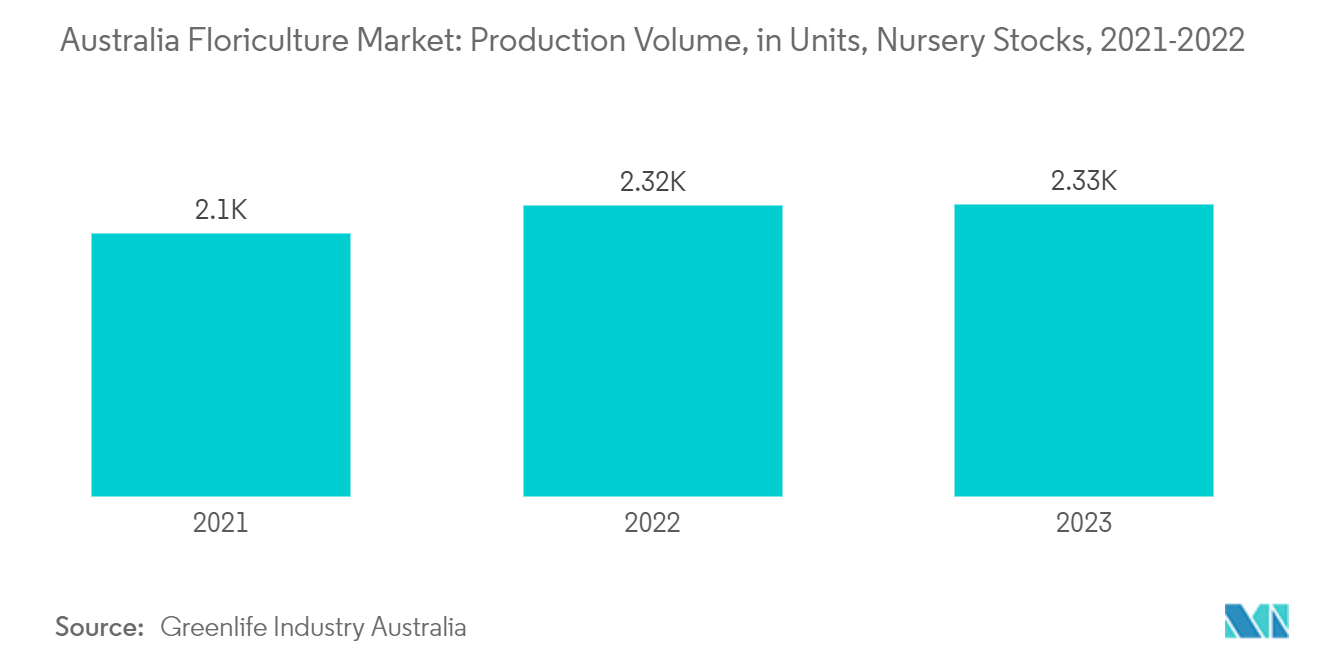Australia Floriculture Market Size

| Study Period | 2019 - 2029 |
| Base Year For Estimation | 2023 |
| Forecast Data Period | 2024 - 2029 |
| Market Size (2024) | USD 2.70 Billion |
| Market Size (2029) | USD 3.30 Billion |
| CAGR (2024 - 2029) | 4.10 % |
Major Players*Disclaimer: Major Players sorted in no particular order |
Australia Floriculture Market Analysis
The Australia Floriculture Market size is estimated at USD 2.70 billion in 2024, and is expected to reach USD 3.30 billion by 2029, growing at a CAGR of 4.10% during the forecast period (2024-2029).
- Australia's floriculture market plays a pivotal role in the country’s agricultural sector, making notable contributions to the economy and job market. According to Agriculture Victoria, a partnership organization, floriculture jobs represent 9% of all agricultural employment in Victoria. The key flower-producing regions in Australia include Perth, Wimmera, Southeast Queensland, Northern Rivers, Central Coast, and Melbourne. In these regions, flower cultivation takes place in advanced glasshouses, simpler protected cropping setups, and open outdoor fields that feature a mix of expansive commercial enterprises and specialized niche growers. Additionally, the popular flowers cultivated in Australia encompass Desert Flame, Grevillea, Kangaroo Paws, Canberra Bells, Pink Rock Lily, Aussie Box, Bottle Brushes, and Chorizema.
- Additionally, the country’s cut flower industry plays a pivotal role in Australia's floriculture market, which is valued in the billions annually. While flowers are cultivated year-round, demand peaks in February and May, coinciding with Valentine's Day and Mother's Day, and there is a smaller surge in December for Christmas. In the last decade, the native flower segment witnessed significant growth, welcoming a surge of new growers. Coastal regions, particularly the Mid-North and North Coast, now host most of these growers. This growth can be attributed to the establishment of crop-based networks and enhanced collaborations between research institutions and the market.
- Consumer demand for Australian flowers is on the rise, largely due to the region's renowned floral prominence. In response, the government is making investments to bolster the market. For example, in 2024, the Albanese government allocated USD 1.1 million to the "Showcasing Australian Horticulture" program, underscoring its commitment to Australia's horticulture industry and its world-class produce. Such initiatives boost the country's floriculture development and fuel market growth. Thus, government backing and ongoing expansions are expected to propel the market's growth during the forecast period.
Australia Floriculture Market Trends
The Demand for Cut Flowers is Growing
- Cut flowers are woven into the fabric of the culture, playing a pivotal role in traditions, celebrations, and everyday life in Australia. They are majorly grown in Victoria, Western Australia, and Queensland. They are central to many cultural and social events. The rising trend of using floral arrangements for home decor has further boosted the demand for cut flowers. However, despite this growing interest, Australia has witnessed a decline in flower production. According to the Australian Bureau of Statistics, the production value of cut flowers in Australia fell from USD 218.2 million in 2022 to USD 204.7 million in 2023.
- Despite the declining domestic cut flower production, the local demand is growing, thus increasing the country’s reliance on imports from various countries such as Malaysia, Vietnam, Kenya, and China. According to the Flowers Association, imports of cut flowers from Vietnam to Australia surged from 6.2 million metric tons in 2022 to 13.3 million metric tons in 2023. This uptick in imports underscores the robust demand for cut flowers in Australia, which may further boost the market’s growth during the forecast period.
- Companies in the market are rolling out new flower varieties, spurring an uptick in cut flower purchases across the nation. For instance, in 2022, Helix Australia debuted the Chamelaucium, commonly known as the waxflower, a quintessential filler in the cut flower arena. These novel waxflower variants enhance the beauty and texture of bouquets, thus boosting their demand and leading to market expansion.

The Nursery Stocks Segment Dominates the Market
- In Australia, nursery stocks encompass a variety of plants, including trees, shrubs, vines, buds, and annual flowering plants, all cultivated for sale and distribution. While production spans all states and territories, the majority is concentrated in Victoria, Queensland, and New South Wales. These plants are available throughout the year, but sales peak in spring, particularly for ornamental retail lines. Australian nursery stock production employs three distinct farming systems, where conventional systems contribute to 83% of the production value, followed by glasshouses with 13% and polyhouses and tunnels with 4%.
- In Australia, gardening continues to be a favored pastime, fueling a steady demand for nursery stocks. Garden enthusiasts are always on the lookout for diverse plants, whether for home gardens, landscaping, or indoor decoration. This heightened interest bolsters the gardening retail industry and propels the growth of nursery stocks.
- According to the Australian Bureau of Statistics, Australia is home to 2,492 active garden supplies retail businesses. The rising demand for nursery stocks also bolstered their production in the country during the study period. For instance, according to Greenlife Industry Australia and Hort Innovation, nursery stock production increased from 2,100 units in 2020 to 2,334 units in 2022. This uptick in production meets local demand, thereby reinforcing the market.

Australia Floriculture Market News
- May 2023: A Victorian flower farmer launched "Grown Not Flown," a digital marketplace that links consumers directly with local flower farms. This app supports the "slow flower movement," promoting connections between flower buyers and sustainable local producers, and advocates for purchasing local produce.
- August 2022: Lynch Group Holdings distributed millions of perishable flowers with a shelf-life of 5-7 days among retailers of Australian and Chinese retailers. The Sydney-based company has found business opportunities in China, believing that the boom in middle-income consumption will boost flower demand.
- January 2022: The Australian investment firm Alceon Group acquired Sydney-based garden center chain Flower Power, which could value the retailer and its properties at close to USD 500 million, to escalate the flower business in the country.
Australia Floriculture Market Report - Table of Contents
1. INTRODUCTION
- 1.1 Study Assumptions and Market Definition
- 1.2 Scope of the Study
2. RESEARCH METHODOLOGY
3. EXECUTIVE SUMMARY
4. MARKET DYNAMICS
- 4.1 Market Overview
-
4.2 Market Drivers
- 4.2.1 Increasing Flower Retail Sales
- 4.2.2 Growing Demand for Cut Flowers
- 4.2.3 Favorable Agro-climatic Conditions in the Country
-
4.3 Market Restraints
- 4.3.1 Rising Incidence of Insect Infestations
- 4.3.2 Stringent Trade Regulations
-
4.4 Porter's Five Forces Analysis
- 4.4.1 Bargaining Power of Suppliers
- 4.4.2 Bargaining Power of Buyers
- 4.4.3 Threat of New Entrants
- 4.4.4 Threat of Substitutes
- 4.4.5 Intensity of Competitive Rivalry
5. COUNTRY PROFILE
- 5.1 PESTLE Analysis
6. MARKET SEGMENTATION
-
6.1 Type of Flower
- 6.1.1 Rose
- 6.1.2 Tulip
- 6.1.3 Chrysanthemum
- 6.1.4 Gerbera
- 6.1.5 Freesia
- 6.1.6 Lily
- 6.1.7 Orchid
- 6.1.8 Nursery Stock
- 6.1.9 Other Types of Flowers
7. VALUE CHAIN ANALYSIS AND DISTRIBUTION ANALYSIS
- 7.1 Value Chain Analysis
- 7.2 Distribution Channel Analysis
-
7.3 Trade Analysis
- 7.3.1 Import Analysis
- 7.3.2 Export Analysis
8. MARKET OPPORTUNITIES AND FUTURE TRENDS
** Subject To AvailablityAustralia Floriculture Industry Segmentation
Floriculture is a type of horticulture practice that focuses on cultivating flowering and ornamental plants for gardens and commercial use. The Australian floriculture market is segmented by type of flowers into roses, tulips, chrysanthemums, gerberas, freesias, lilies, orchids, nursery stocks, and other types of flowers. The report offers market size and forecasts in terms of value (USD) for the above segments.
| Type of Flower | Rose |
| Tulip | |
| Chrysanthemum | |
| Gerbera | |
| Freesia | |
| Lily | |
| Orchid | |
| Nursery Stock | |
| Other Types of Flowers |
Australia Floriculture Market Research FAQs
How big is the Australia Floriculture Market?
The Australia Floriculture Market size is expected to reach USD 2.70 billion in 2024 and grow at a CAGR of 4.10% to reach USD 3.30 billion by 2029.
What is the current Australia Floriculture Market size?
In 2024, the Australia Floriculture Market size is expected to reach USD 2.70 billion.
What years does this Australia Floriculture Market cover, and what was the market size in 2023?
In 2023, the Australia Floriculture Market size was estimated at USD 2.59 billion. The report covers the Australia Floriculture Market historical market size for years: 2019, 2020, 2021, 2022 and 2023. The report also forecasts the Australia Floriculture Market size for years: 2024, 2025, 2026, 2027, 2028 and 2029.
Floriculture in Australia Industry Report
Statistics for the 2024 Floriculture in Australia market share, size and revenue growth rate, created by Mordor Intelligence™ Industry Reports. Floriculture in Australia analysis includes a market forecast outlook to 2029 and historical overview. Get a sample of this industry analysis as a free report PDF download.



